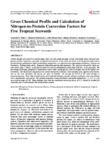Por favor, use este identificador para citar o enlazar este ítem:
http://www.alice.cnptia.embrapa.br/alice/handle/doc/906503Registro completo de metadatos
| Campo DC | Valor | Lengua/Idioma |
|---|---|---|
| dc.contributor.author | DINIZ, G. S. | pt_BR |
| dc.contributor.author | BARBARINO, E. | pt_BR |
| dc.contributor.author | OIANO-NETO, J. | pt_BR |
| dc.contributor.author | PACHECO, S. | pt_BR |
| dc.contributor.author | LOURENÇO, S. O. | pt_BR |
| dc.date.accessioned | 2011-11-21T11:11:11Z | pt_BR |
| dc.date.available | 2011-11-21T11:11:11Z | pt_BR |
| dc.date.created | 2011-11-21 | pt_BR |
| dc.date.issued | 2011 | pt_BR |
| dc.identifier.citation | American Journal of Plant Sciences, v. 2, n. 3, p. 287-296, 2011. | pt_BR |
| dc.identifier.uri | http://www.alice.cnptia.embrapa.br/alice/handle/doc/906503 | pt_BR |
| dc.description | Despite decades of research on marine algae, there are still significant gaps in basic knowledge about chemical com-position of these organisms, especially in tropical environments. In this study, the amino acid composition and contents of total nitrogen, phosphorus, lipid, carbohydrate and protein were determined in Asparagopsis taxiformis, Centroceras clavulatum, Chaetomorpha aerea, Sargassum filipendula and Spyridia hypnoides. The seaweeds showed low lipid con-tents (lower than 5.5% d.w. in all species) and were rich in carbohydrates (more than 16% d.w. in all seaweeds). The percentage of nitrogen, phosphorus and protein varied widely among species, which red algae showed the highest con-centrations. The amino acid composition was similar among the seaweeds, which glutamic acid, aspartic acid and leu-cine as the most abundant. All species are poor in histidine. An average of 24.2% of the total nitrogen is non-proteinaceous. From data of total amino acid and total nitrogen, specific nitrogen-to-protein conversion factors were calculated for each species. The nitrogen-to-protein conversion factors calculated ranged from 4.51 to 5.21, with an overall average of 4.86. These findings show that the traditional conversion factor of 6.25 should be avoided for seaweeds, since it overestimates the actual protein content. | pt_BR |
| dc.language.iso | eng | eng |
| dc.rights | openAccess | eng |
| dc.title | Gross chemical profile and calculation of nitrogen-to-protein conversion factors for five tropical seaweeds. | pt_BR |
| dc.type | Artigo de periódico | pt_BR |
| dc.date.updated | 2011-11-21T11:11:11Z | pt_BR |
| dc.subject.thesagro | Proteína | pt_BR |
| dc.subject.thesagro | Alga marinha | pt_BR |
| dc.subject.thesagro | Aminoácido | pt_BR |
| dc.subject.nalthesaurus | Macroalgae | pt_BR |
| dc.subject.nalthesaurus | Proteins | pt_BR |
| dc.subject.nalthesaurus | Amino acids | pt_BR |
| riaa.ainfo.id | 906503 | pt_BR |
| riaa.ainfo.lastupdate | 2011-11-21 | pt_BR |
| dc.identifier.doi | 10.4236/ajps.2011.23032 | pt_BR |
| dc.contributor.institution | GRACIELA S. DINIZ, UFF; ELISABETE BARBARINO, UFF; JOAO OIANO NETO, CPPSE; SIDNEY PACHECO, CTAA; SERGIO O. LOURENÇO, UFF. | pt_BR |
| Aparece en las colecciones: | Artigo em periódico indexado (CTAA)  | |
Ficheros en este ítem:
| Fichero | Descripción | Tamaño | Formato | |
|---|---|---|---|---|
| 2011058.pdf | 345,23 kB | Adobe PDF |  Visualizar/Abrir |









